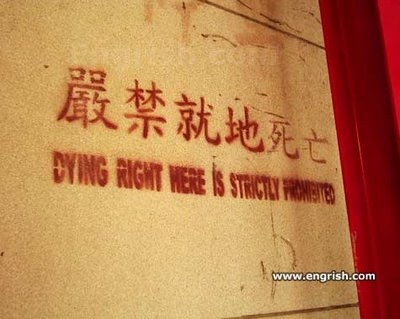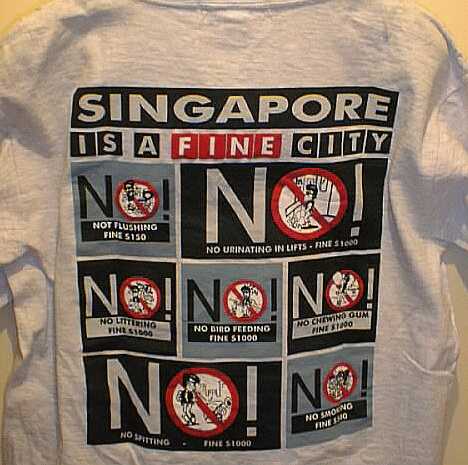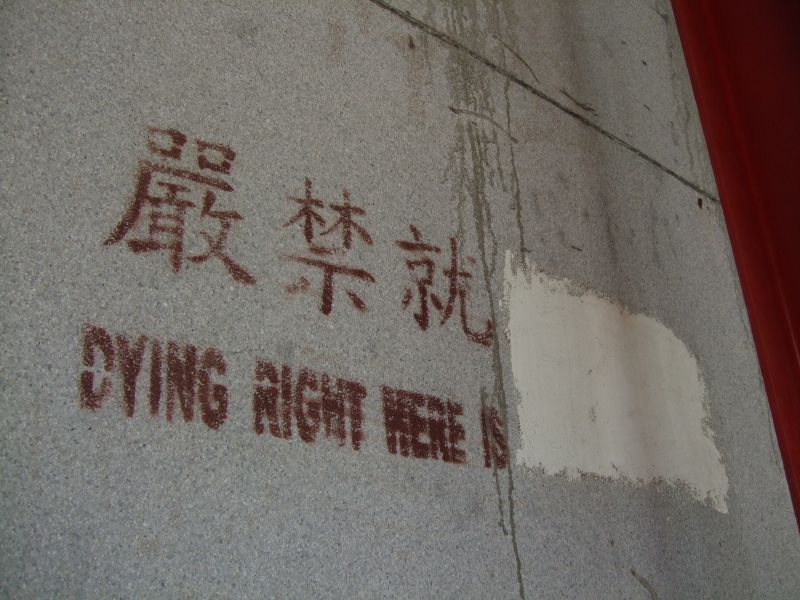Forbidden to die
« previous post | next post »
Going through the latest batch of Chinglish offerings that friends sent to me last week, my eye was caught by this striking bilingual sign:

Normally, I do little more than marvel at the mistranslations and ungrammatical constructions that are characteristic of Chinglish. Seldom do I undertake deeper research into how they came about, since the causes of the bloopers and blunders are usually painfully obvious. It is only when Chinglish expressions — whether humorous or not — are hard to explain that I make a special effort to analyze them and figure out how they occurred.
But this one was different.
What struck me about this classic specimen — sardonically captioned by the Engrish.com editor(s) thus: "Go over there to die, please. Thank you." — was the fact that the Chinese is just as ridiculous as the English: yan2jin4 jiu4di4 si3wang2 ("[It is] strictly prohibited to die on [this] spot"). Furthermore, the English — unlike most Chinglish — is a reasonably accurate translation of the Chinese. That's what really caught my attention about this very special instance of supposed Chinglish. Consequently, I decided that this "DYING RIGHT HERE IS STRICTLY PROHIBITED" sign merited further investigation.
The first aspect of the sign that had to be determined was the context in which it appeared. In what circumstances would it be appropriate to tell people to die elsewhere? The emergency room of a hospital? It turns out that the "DYING RIGHT HERE IS STRICTLY PROHIBITED" sign was painted on the wall of a building in the celebrated Taipei district called Huashan Culture Park 華山藝文特區, an artsy area like Soho in New York or 798 in Beijing. You can find a map and photographs of the area here, and pictures here. The exact address of the sign is apparently "原台北酒場,八德路和忠孝東路二段上的一大片廣場"。
Right away, one suspects that artistic playfulness and bohemian irony are operative in the sign under discussion. This suspicion is further confirmed by close examination of the printing of the Chinese characters, where si3wang2 ("to die; to be dead / doomed") is in a different, thinner font. This suggests the possibility that si3wang2 would be replaceable with other activities and behaviors that are "strictly prohibited." Indeed, one often finds similar injunctions against lesser infractions than dying: spitting, urinating, defecating, and so on.
A blogger from Taiwan offers additional views of the sign and agrees with the assessment that it is ironic and playful.
What this clever bilingual sign accomplishes, then, is to make a social comment that is both dramatic and subtle: one is not even permitted to die. Incidentally, a couple of Chinese informants insisted that the sign is "ungrammatical" because si3wang2 as a verb, unlike committing suicide, is an involuntary act, hence one cannot be enjoined against doing it. Be that as it may, this remarkable Taipei sign reminds me somewhat of the famous T-shirts that say "Singapore Is a Fine City" on the front or at the top and lists a number of the many fines imposed by the government on the back or below:

Unfortunately, I must close this post with a sad finale. The "DYING RIGHT HERE IS STRICTLY PROHIBITED" sign in Taipei, which deserves to be considered a work of art, has been defaced:
A tip of the hat to Mark Swofford, Gianni Wan, K. H. Cheung, Selena Wang, Tim Xie, William Zhang Zesheng, Valerie Hansen, and Lala Zuo for various types of assistance during my research on this singular sign.

TootsNYC said,
June 9, 2008 @ 10:56 am
I'm a big fan of Captain Underpants. In one of the books, Melvin runs the world, and he posts signs that say things like "Breathing is prohibited"–the capper is a sign that says "No reading this sign."
Kris Rhodes said,
June 9, 2008 @ 10:57 am
If I'm remembering my Japanese kanji correctly, it appears they've erased "dying" in the Chinese while only erasing "strictly prohibited" in the English. That's kind of funny–the message can still be recovered at least if you know both languages.
-Kris
Jean-Sébastien Girard said,
June 9, 2008 @ 11:21 am
Not to mention that there are places where dying is forbidden.
Chad Nilep said,
June 9, 2008 @ 11:24 am
'Incidentally, a couple of Chinese informants insisted that the sign is "ungrammatical" because si3wang2 as a verb, unlike committing suicide, is an involuntary act, hence one cannot be enjoined against doing it.'
IDSCB (I don't speak Chinese, but…) That wouldn't make the sentence "ungrammatical" in the sense of being syntactically ill-formed, though, would it? It is merely infelicitous, in the sense of being pragmatically inappropriate – just like the English translation.
By the way, can't the final sign be read as a bilingual focus construction? "yan2jin4jiu4, dying right here is" (Forbidden, dying right here is).
Josh Millard said,
June 9, 2008 @ 11:41 am
IDSCB (I don't speak Chinese, but…) That wouldn't make the sentence "ungrammatical" in the sense of being syntactically ill-formed, though, would it? It is merely infelicitous, in the sense of being pragmatically inappropriate – just like the English translation.
I was curious about that, too. Is there something else going on in Chinese grammar that'd make the die-vs-commit-suicide grammatically problematic, verb agreement* or some such? Or is this just a case (the scare quotes perhaps suggesting as much) of the casual little-g grammar sense of ungrammatical-as-weird?
*for the sake of argument, here's a nonce bad-English analog: "I am going to die myself with a gun", with die for kill. Transitivity rears its ugly head. Is there a similar structural issue going on with the Chinese example, or is more of a furiously sleeping ideas situation?
Gavin Mac said,
June 9, 2008 @ 12:15 pm
Is it possible, perhaps, that the sign was originally a prohibition for something else (standing?) which was mistranslated into English as "dying"? Some of the local artsy bilingual types may have then taken it upon themselves to "fix" the Chinese instead of the English.
Rory said,
June 9, 2008 @ 12:58 pm
The printing of the sign looks very much to me like a spraypainted stencil job – the kind of avant-garde art graffiti that isn't unusual in an "artsy area like Soho in New York".
Sanverde said,
June 9, 2008 @ 2:25 pm
When words aren't required, there's always a simple sign:
http://www.flickr.com/photos/sanverde/1593757329/in/set-72157600291385758/
Still, that leaves the question open as to where car bombs are permitted.
Elyaqim Mosheh Adam said,
June 9, 2008 @ 2:56 pm
Those who read Chinese may want to enter “嚴禁就地死亡” into a search engine. In Google, even with quotation marks around it, there were 287 results, including 74 images (many of the exact same sign). Unfortunately, I cannot read most of the results. Perhaps there is information on the stencil or the artist/activist (if that interpretation is correct).
Sili said,
June 9, 2008 @ 3:14 pm
That's just fine.
Rubrick said,
June 9, 2008 @ 5:16 pm
Such a sign would be quite logical, if ineffective, on, say, the Golden Gate Bridge.
dr pepper said,
June 9, 2008 @ 6:55 pm
What's the middle one– No Confederate Flags without Stars?
Paul Wilkins said,
June 9, 2008 @ 7:17 pm
An ancient Chinese proverb says that one who overanalyzes jokes is doomed to never laugh again.
Victor, I thought your second tag was off-base, but apparently you got it right. The humor was lost (at least for some) in the translation. Great post. I'm rushing off to my CafePress store to sell this one…
Michael Roberts said,
June 9, 2008 @ 10:29 pm
In Hungarian, it's considered ungrammatical to use "hiccup" in the imperative, for the same reason (to wit, that hiccuping is involuntary.) I always found it hilarious to maintain that a perfectly regular verb didn't have an imperative form because people think you can't stop hiccuping and therefore there is no reason ever to use an imperative form. (And even though when I tell Hungarians not to hiccup, they somehow manage to understand what I'm saying, at least sufficiently well to tell me I'm speaking ungrammatically.)
rpsms said,
June 10, 2008 @ 1:33 pm
"Short Timers" (Kubrick's "Full Metal Jacket" is derived from this book) mentions several times how Marines get in trouble if they get shot because they are not allowed to die without permission.
Marv Lurie said,
June 10, 2008 @ 3:22 pm
I once encountered a form which required that I notify the head office if I died.
Janice Huth Byer said,
June 10, 2008 @ 5:23 pm
To Chad Nilep's correct observation that it's not ungrammatical to use a word for dying that excludes suicide, I'd add that it's merely better, being more absurd, which is the whole point, right?
marie-lucie said,
June 10, 2008 @ 6:55 pm
I once read about a linguist doing field work in India and trying to get an imperative form for the verb meaning 'to die'. Most consultants insisted that there was no such form, but finally one person recalled that a harassed mother might say to her rambunctious or whiny child "Die!" – of course not meaning it literally.
In doing standard fieldwork it quite often happens that in response to questioning, consultants insist that there is no word or form for meaning X, but come up spontaneously with the very item in other contexts.
Josh Millard said,
June 10, 2008 @ 7:27 pm
Aye, marie-lucie — it seems like, if nothing else, an imperative 'die' would be almost a necessity in any culture with a sufficiently advanced action film industry.
Randy Alexander said,
June 11, 2008 @ 11:51 pm
There's something very strange about the second photo. The way the white patch was applied, it shouldn't cover up the baseline of the letters, so you should still be able to see them a little at the bottom. Also it doesn't look wide enough to cover up the end of "prohibited" (even taking into account that the angle and distance of the second photo are different from those of the first).
BTW, I'm not trying to demonstrate anything by this; just putting forth an observation.
mbeatini said,
June 12, 2008 @ 12:32 am
Could this possibly imply that dying wrong here is OK?
Josh Millard said,
June 12, 2008 @ 2:03 am
Randy Alexander, I had the same thought. I had dismissed it as perhaps a trick of perspective (a gentle curve in upward in the lower English portion of the stencil, maybe?), but since you brought it up as well I decided to check it out.
Here is a diff of the two images; I manually adjusted the perspective of the first image to match the second one, and blew it to greyscale and attempted to match the tones fairly well. It's an imperfect job — different focal lengths in the two shots means some distortion of the images that's hard to correct for with simple tweaking — but even with the fudge factor it seems like there's clearly some text missing from the bottom edge of the painted-over region.
No idea what the story is there, though; did they scrub first, paint second? Is it possible that our before-and-after is actually somehow after-and-before? One thing I noticed when in the first photo is the much thinner strokes on the last two Chinese characters than on the first four. It could be a badly cut stencil, or it could be two separate stencils cut at two different times or by two different hands. Why they'd do it in pieces, I don't know, but it's one of the little oddities of the initial photo.
Randy Alexander said,
June 12, 2008 @ 11:05 am
Josh, thanks! I don't have the software to do that on this machine, so I was hoping that someone would try it (but I forgot to say so). Mind-reading is a useful skill. Keep it up.
Victor mentioned the "different, thinner font" for the 死亡, and it may be that the English translation was added after the 死亡 or even at the same time.
Very mysterious indeed.
Andrew said,
June 13, 2008 @ 12:24 pm
In addition to the whitewash not covering the same area as the original text, the text in Chinese is rendered just as ungrammatical as the English. 就地 means "right here", and it is split apart. 就 needs to bind to something on the right, to the best of my knowledge.